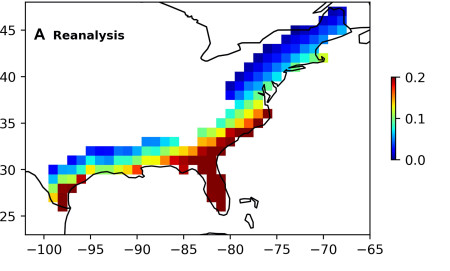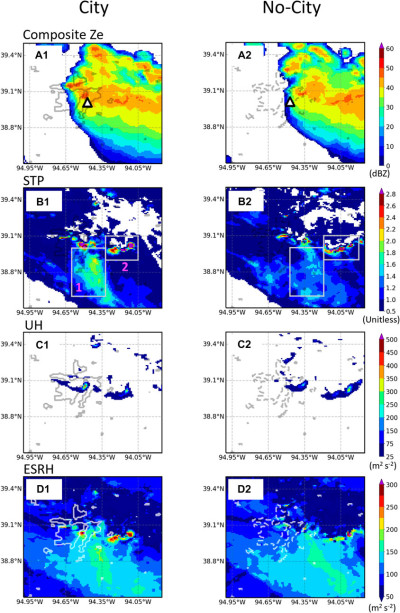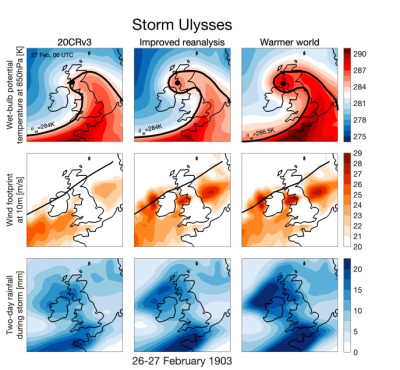Three New Studies Emerge from NERSC Research on Climate Change, Extreme Weather
June 21, 2023
By Keri Troutman
Contact: cscomms@lbl.gov
Understanding how climate change influences extreme weather has become an increasingly important scientific focus over the past few decades. Scientists’ ability to connect changing climate conditions to weather patterns parallels advances in computing. While climate research is computationally expensive, researchers are constantly working to develop techniques to process more data in a shorter amount of time, while supercomputers themselves continue to evolve.
The National Energy Research Scientific Computing Center (NERSC) at Lawrence Berkeley National Laboratory (Berkeley Lab) is a hub for climate and weather research—and three recent scientific journal articles all published within one month highlight NERSC’s role in this field. Looking at tornadoes, hurricanes, and historic storms of the past, various research groups used innovative computational methods at NERSC to delve deeper into climate change and weather.
Researchers from Pacific Northwest National Lab (PNNL), for example, used NERSC supercomputers to understand more about how climate change causes hurricanes to become stronger and strike more often on the U.S. Gulf and lower East coasts. In a paper published in Science Advances in April, the scientists describe the newly understood mechanism that fuels these stronger and more frequent hurricanes: a combination of warming sea surface temperatures and corresponding atmospheric circulation changes.

Projected change in U.S. hurricane risk based on Risk Analysis Framework for Tropical Cyclones (RAFT). Here, climatological coastal hurricane frequency (CHF), defined as the number of 6-hour hurricane track locations per square degree per year show that the Gulf Coast and the lower East Coast (south of 40°N) have experienced higher hurricane risk than the upper East Coast (north of 40°N) from 1979 to 2018. Regions that have been particularly vulnerable to hurricanes include the lower East Coast, Florida, and the coasts of Texas and Louisiana.
“Under climate change, a warming sea surface in the Eastern Pacific Ocean would trigger a wave-like response in the Earth’s upper atmosphere, with the end result being circulation changes that will steer hurricanes increasingly towards the U.S. Gulf and lower East coasts,” said the study’s lead author and PNNL climate scientist Karthik Balaguru. The circulation changes would not only push storms toward the coast but also reduce wind shear at the coast, so as these storms approach the coast they’d also grow stronger, he added.
The key to this discovery was a unique model developed by PNNL, the Risk Analysis Framework for Tropical Cyclones (RAFT), which combines physics, statistics, and machine learning to produce large ensembles of storms. RAFT is essentially a “synthetic hurricane generator” that runs in combination with climate models and makes powerful statistical analyses possible. Balaguru said that in this study, RAFT allowed them to predict risk into the future more robustly with the ability to simulate many storms at a very low computational cost. Given the limited amount of observational data on hurricanes and the high computational cost of running high resolution climate models of the storms, modeling frameworks such as RAFT allow scientists to overcome those challenges.
“There have been some other studies in the past that have tried to address how climate change would affect the behavior of hurricanes,” said Balaguru. “But our study was the first that demonstrated a physical mechanism that explains why wind shear should change or reduce near the coast.”’
Michael Wehner, a senior scientist in Berkeley Lab’s Applied Mathematics and Computational Research Division (AMCR) and one of the study co-authors, noted that since this research looks far into the future, the reality depends on how much we control greenhouse gases in the near term.
“A paper like this is like a warning in that if we don’t get serious about climate change, there are lots of serious consequences, and this is just one of them,” said Wehner.

Comparisons in (A1,A2) composite radar reflectivity, (B1,B2) significant tornado parameter (STP), (C1,C2) 100m-3 km updraft helicity, and (D1,D2) effective storm-relative helicity (ESRH) between the City (left column) and No City (right column) simulations. The white triangle in (A1,A2) indicates the location of the first tornado report.
Urbanization and Climate Change
A similar warning comes from another paper published within days of Balaguru’s, in this case the weather event being tornadoes and the research resulting in the first detailed study showing that urbanization could enhance tornado formation. Led by another PNNL scientist, Jiwen Fan, researchers used NERSC’s Cori system to run advanced climate models of supercell storms around Kansas City and found that urbanization can act to strengthen temperature and moisture gradients at the urban-rural boundary, which then has the potential to create a stronger circulation that in turn can strengthen supercell storms in the vicinity of the city. The strong supercell leads to the stronger outflow fronts that causes a line of rotation feeding the updrafts and enhances the probability of tornadoes. Without the urbanization, researchers found that storms would not propagate over Kansas City as often, but instead they would tend to veer toward the northeast and remain much weaker, said Fan.
Published in Frontiers in Earth Science, the study was the first to demonstrate a potential mechanism for how tornadoes gain momentum near urban areas. The mechanisms leading to the enhanced tornado potential in this study involved processes that are general intrinsic properties of supercell storms, so the researchers believe their work to be instructive in exploring the impact of urbanization in other supercell storms, said Fan. A more systematic examination would achieve a more general conclusion, but there is a large computational cost associated with the detailed physics simulations the PNNL researchers used at NERSC, so future research conclusions that generalize these results will take some time.
“We show that the urban land use in Kansas City acted to pull the storm over the urban area,” said Fan. “With increasing population around the world, this increasing urbanization could impact severe supercell storms in much more complicated ways in the future.”
An Historic Perspective
Published just weeks later in EGUsphere, yet another NERSC-powered study took a new approach to look at how a historic weather event would play out in a warmer world. The research used a novel reanalysis method and the Cori supercomputer to examine a severe windstorm, known as Storm Ulysses, that occurred in February 1903. Taking into consideration climate change, scientists found that the storm would be much more damaging if it occurred today rather than 120 years ago, producing higher wind speeds and increased rainfall.

The columns represent the original 20th Century Reanalysis v3 (20CRv3; left), the improved reanalysis (middle) and the warmer world simulation (right) of Storm Ulysses.
“The method we used for this reanalysis was totally new,” said co-author Gil Compo, a senior research scientist at CIRES, an institute at the University of Colorado Boulder. Instead of the usual simulation method where scientists constrain greenhouse gases or sea surface temperatures and let all weather factors evolve freely to get the data needed for a plausible attribution statement, in this case Compo and his co-authors kept all the features of the storm intact by constraining key aspects of weather with actual observations of Storm Ulysses and gathered data on how the unconstrained components of the weather changed. Their novel “reanalysis in a warmer world” used a system developed using NERSC supercomputers, the NOAA-CIRES-DOE 20th Century Reanalysis v3 (20CRv3), which assimilates surface pressure observations into a NOAA weather forecast model to reconstruct the atmospheric circulation from 1806-2015 at extremely high resolution.
“What we’re doing is saying what’s the sensitivity for a particular weather event if we have sea surface temperatures that are two degrees warmer,” said Compo, who is also affiliated with the National Oceanic and Atmospheric Administration (NOAA) Physical Sciences Laboratory and is a longtime NERSC user. “The big thing we see, and it’s not surprising, is that there’s more water vapor in the air with higher sea surface temperatures so you get more precipitation. What was surprising was that we got even stronger winds, even with constraining the pressure field, and we also found warmer land values reconstructed far away from the coast, which we didn’t totally expect just from warmer sea surface temperatures and constrained surface pressure.”
As more extreme weather events become more common, the role of scientific research focused on understanding the relationship between weather and climate change becomes more significant. And likewise, so does the importance of having supercomputing facilities such as NERSC to assist researchers. “At NERSC, the people in charge really seem responsive to the users’ scientific needs,” said Compo. “I really count on NERSC for a lot of my research, and the world-class capabilities and data scientists there have been integral to our work.”
NERSC is a U.S. Department of Energy Office of Science user facility.
About NERSC and Berkeley Lab
The National Energy Research Scientific Computing Center (NERSC) is a U.S. Department of Energy Office of Science User Facility that serves as the primary high performance computing center for scientific research sponsored by the Office of Science. Located at Lawrence Berkeley National Laboratory, NERSC serves almost 10,000 scientists at national laboratories and universities researching a wide range of problems in climate, fusion energy, materials science, physics, chemistry, computational biology, and other disciplines. Berkeley Lab is a DOE national laboratory located in Berkeley, California. It conducts unclassified scientific research and is managed by the University of California for the U.S. Department of Energy. »Learn more about computing sciences at Berkeley Lab.







